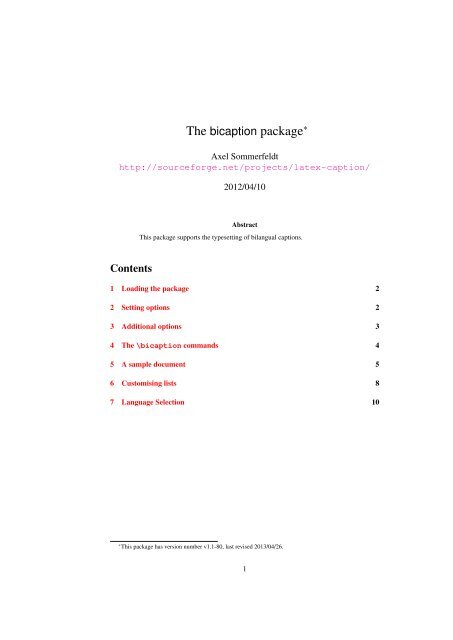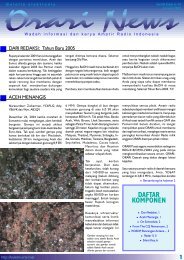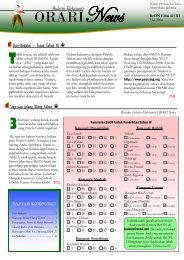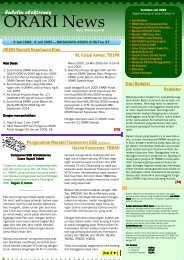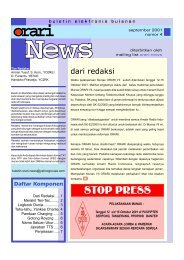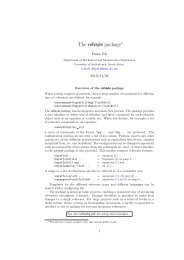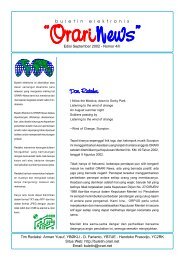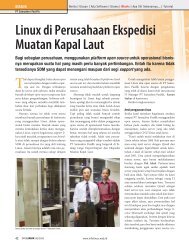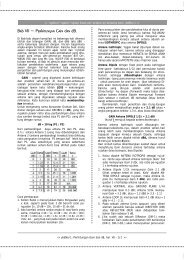The bicaption package - Kambing UI
The bicaption package - Kambing UI
The bicaption package - Kambing UI
You also want an ePaper? Increase the reach of your titles
YUMPU automatically turns print PDFs into web optimized ePapers that Google loves.
<strong>The</strong> <strong>bicaption</strong> <strong>package</strong> ∗<br />
Axel Sommerfeldt<br />
http://sourceforge.net/projects/latex-caption/<br />
Contents<br />
2012/04/10<br />
Abstract<br />
This <strong>package</strong> supports the typesetting of bilangual captions.<br />
1 Loading the <strong>package</strong> 2<br />
2 Setting options 2<br />
3 Additional options 3<br />
4 <strong>The</strong> \<strong>bicaption</strong> commands 4<br />
5 A sample document 5<br />
6 Customising lists 8<br />
7 Language Selection 10<br />
∗ This <strong>package</strong> has version number v1.1-80, last revised 2013/04/26.<br />
1
\use<strong>package</strong><br />
\captionsetup<br />
1 Loading the <strong>package</strong><br />
This <strong>package</strong> will be loaded by<br />
\use<strong>package</strong>[〈options〉]{<strong>bicaption</strong>} .<br />
<strong>The</strong> options for the <strong>bicaption</strong> <strong>package</strong> are the same ones as for the caption <strong>package</strong> and<br />
specify settings which are used for the second language additionally. In fact<br />
\use<strong>package</strong>[〈options〉]{<strong>bicaption</strong>}<br />
is identical to<br />
\use<strong>package</strong>{<strong>bicaption</strong>}<br />
\captionsetup[bi-second]{〈options〉} .<br />
When used with the babel or polyglossia <strong>package</strong>, the <strong>bicaption</strong> <strong>package</strong> should be loaded<br />
after it, so the main language will be set automatically. See section 7 for details.<br />
2 Setting options<br />
\captionsetup[bi]{〈options〉}<br />
do setup options which will be used for bilanguage captions additionally to the ones<br />
which are setup for the specific floating environment.<br />
\captionsetup[bi-first]{〈options〉}<br />
do setup options which will be used for the first heading of the bilanguage captions additionally<br />
to the ones which are setup for the specific floating environment and the ones<br />
which are setup by \captionsetup[bi]{. . . }.<br />
\captionsetup[bi-second]{〈options〉}<br />
do setup options which will be used for the second heading of the bilanguage captions<br />
additionally to the ones which are setup for the specific floating environment and the ones<br />
which are setup by \captionsetup[bi]{. . . }.<br />
Options specified with \use<strong>package</strong>[. . . ]{<strong>bicaption</strong>} and \captionsetup[bi. . . ]{. . . }<br />
will override the ones specified by \captionsetup{. . . } and \captionsetup[figure]{.<br />
. . } (same for ‘table’). So finally we have the following order how settings for<br />
bilingual captions are applied:<br />
1. Global settings (\use<strong>package</strong>[. . . ]{caption} and \captionsetup{. . . })<br />
2. Environmental settings (\captionsetup[figure -or- table]{. . . })<br />
3. Local settings (\captionsetup{. . . } inside figure or table environment)<br />
2
language=<br />
bi-lang=<br />
4. Custom ‘bi’ settings (\captionsetup[bi]{. . . })<br />
5. Custom ‘bi-first’ resp. ‘bi-second’ settings (\use<strong>package</strong>[. . . ]{<strong>bicaption</strong>} and<br />
\captionsetup[bi-first]{. . . } resp. \captionsetup[bi-second]{. . . })<br />
An example:<br />
\use<strong>package</strong>[labelsep=quad,indention=10pt]{caption}<br />
\use<strong>package</strong>[labelfont=bf]{<strong>bicaption</strong>}<br />
\captionsetup[table]{labelfont=it,position=top}<br />
causes the second heading of the bilingual caption inside table environments to be<br />
typeset with the settings<br />
labelsep=quad,indention=10pt,position=top,labelfont=bf .<br />
To limit bi, bi-first, or bi-second options to specific environments one can use<br />
multiple optional arguments for \captionsetup, e.g.:<br />
\captionsetup[figure][bi-first][〈options〉]<br />
will limit the settings to the first heading of figure environments only. Please note that<br />
the environment name has to be specified as first optional argument while the bilingual<br />
selection as second one.<br />
3 Additional options<br />
<strong>The</strong>se options are available additional to the ones offered by the caption <strong>package</strong>:<br />
lang= Sets the language of the caption, e.g.<br />
\use<strong>package</strong>[lang=english]{<strong>bicaption</strong>}<br />
will typeset the second caption of bilingual captions in English. (<strong>The</strong><br />
language will be set with \selectcaptionlanguage internally,<br />
see section 7 for details.)<br />
bi-lang= Causes a selection of the headings of bilingual captions.<br />
\captionsetup{bi-lang=both}<br />
will cause that both caption headings are being typeset.<br />
(This is the default.)<br />
\captionsetup{bi-lang=first}<br />
will cause that only the first heading is being typeset, and<br />
\captionsetup{bi-lang=second}<br />
will cause that only the second heading is being typeset.<br />
3
i-singlelinecheck=<br />
bi-swap=<br />
\<strong>bicaption</strong><br />
\<strong>bicaption</strong>box<br />
\bisubcaption<br />
\bisubcaptionbox<br />
bi-slc= Switches the common single-line-check on or off, i.e. when switched<br />
on only a single check will be done for both captions, and the result<br />
will affect both captions afterwards. So if only one caption is longer<br />
than a single line, both captions will be treated as if they are longer<br />
than a single line, even if the second one isn’t. (<strong>The</strong> default is on.)<br />
bi-swap=<br />
\captionsetup{bi-swap}<br />
will swap the primary and secondary language, making the first language<br />
the second one and vice versa. (<strong>The</strong> default is false.)<br />
4 <strong>The</strong> \<strong>bicaption</strong> commands<br />
Bilingual captions will be typeset by<br />
\<strong>bicaption</strong>[〈list entry #1〉]{〈heading #1〉}<br />
[〈list entry #2〉]{〈heading #2〉}<br />
\<strong>bicaption</strong>*{〈heading #1〉}{〈heading #2〉}<br />
<strong>The</strong> \label should be placed either after this command, or inside the first heading.<br />
Bilingual caption boxes will be typeset by<br />
\<strong>bicaption</strong>box[〈list entry #1〉]{〈heading #1〉}<br />
[〈list entry #2〉]{〈heading #2〉}<br />
[〈width〉][〈inner-pos〉]{〈contents〉}<br />
\<strong>bicaption</strong>box*{〈heading #1〉}{〈heading #2〉}<br />
[〈width〉][〈inner-pos〉]{〈contents〉}<br />
<strong>The</strong> \label should be placed inside the first heading.<br />
(For a description of the optional parameters 〈width〉 and 〈inner-pos〉 please take a look at the<br />
caption <strong>package</strong> documentation, \captionbox.)<br />
If the subcaption <strong>package</strong> is loaded, these commands are available additionally:<br />
Bilingual sub-captions will be typeset by<br />
\bisubcaption[〈list entry #1〉]{〈heading #1〉}<br />
[〈list entry #2〉]{〈heading #2〉}<br />
\bisubcaption*{〈heading #1〉}{〈heading #2〉}<br />
<strong>The</strong> \label should be placed either after this command, or inside the first heading.<br />
Bilingual sub-caption boxes will be typeset by<br />
\bisubcaptionbox[〈list entry #1〉]{〈heading #1〉}<br />
[〈list entry #2〉]{〈heading #2〉}<br />
[〈width〉][〈inner-pos〉]{〈contents〉}<br />
\bisubcaptionbox*{〈heading #1〉}{〈heading #2〉}<br />
[〈width〉][〈inner-pos〉]{〈contents〉}<br />
<strong>The</strong> \label should be placed inside the first heading.<br />
(For a description of the optional parameters 〈width〉 and 〈inner-pos〉 please take a look at the<br />
subcaption <strong>package</strong> documentation, \subcaptionbox.)<br />
4
5 A sample document<br />
\documentclass[english,ngerman]{article}<br />
\use<strong>package</strong>{selinput}<br />
\SelectInputMappings{adieresis={ä},germandbls={ß}}<br />
\use<strong>package</strong>{babel}<br />
\use<strong>package</strong>[lang=english,font=it]{<strong>bicaption</strong>}<br />
\use<strong>package</strong>[format=hang]{subcaption}<br />
\begin{document}<br />
\begin{figure}[!htb]<br />
\centering<br />
\bisubcaptionbox<br />
{Teilabbildung A\label{fig:test:A}}<br />
{Subfigure A}[0.4\textwidth]{IMAGE}%<br />
\qquad<br />
\bisubcaptionbox<br />
{Teilabbildung langer Titel B\label{fig:test:B}}<br />
{Subfigure long title B}[0.4\textwidth]{IMAGE}%<br />
\<strong>bicaption</strong>{Deutscher Titel}{English Title}<br />
\label{fig:test}<br />
\end{figure}<br />
\captionsetup{bi-lang=both}<br />
\begin{figure}[!htb]<br />
\centering<br />
\bisubcaptionbox[A]<br />
{Und eine gaaaanz lange Caption: Teilabbildung A}<br />
{Subfigure A}[0.4\textwidth]{IMAGE}%<br />
\qquad<br />
\bisubcaptionbox[B]<br />
{Teilabbildung B}<br />
{Subfigure B}[0.4\textwidth]{IMAGE}%<br />
\<strong>bicaption</strong>[Abbildungsverzeichnistitel]<br />
{Und eine noch viel viel viel<br />
längere deutsche Beschriftung: Deutscher Titel}<br />
{Short English heading}<br />
\end{figure}<br />
\captionsetup{bi-slc=0}<br />
\begin{figure}[!htb]<br />
\centering<br />
\bisubcaptionbox[A]<br />
{Und eine gaaaanz lange Caption: Teilabbildung A}<br />
{Subfigure A}[0.4\textwidth]{IMAGE}%<br />
5
\qquad<br />
\bisubcaptionbox[B]<br />
{Teilabbildung B}<br />
{Subfigure B}[0.4\textwidth]{IMAGE}%<br />
\<strong>bicaption</strong>[Abbildungsverzeichnistitel]<br />
{Und eine noch viel viel viel<br />
längere deutsche Beschriftung: Deutscher Titel}<br />
{Short English heading}<br />
\end{figure}<br />
\captionsetup{slc=0}<br />
\begin{figure}[!htb]<br />
\centering<br />
\bisubcaptionbox[A]<br />
{Und eine gaaaanz lange Caption: Teilabbildung A}<br />
{Subfigure A}[0.4\textwidth]{IMAGE}%<br />
\qquad<br />
\bisubcaptionbox[B]<br />
{Teilabbildung B}<br />
{Subfigure B}[0.4\textwidth]{IMAGE}%<br />
\<strong>bicaption</strong>[Abbildungsverzeichnistitel]<br />
{Und eine noch viel viel viel<br />
längere deutsche Beschriftung: Deutscher Titel}<br />
{Short English heading}<br />
\end{figure}<br />
\end{document}<br />
6
IMAGE<br />
(a) Teilabbildung A<br />
(a) Subfigure A<br />
IMAGE<br />
(a) Und eine gaaaanz lange Caption:<br />
Teilabbildung A<br />
(a) Subfigure A<br />
Abbildung 1: Deutscher Titel<br />
Figure 1: English Title<br />
IMAGE<br />
(b) Teilabbildung langer Titel B<br />
(b) Subfigure long title B<br />
IMAGE<br />
(b) Teilabbildung B<br />
(b) Subfigure B<br />
Abbildung 2: Und eine noch viel viel viel längere deutsche Beschriftung: Deutscher Titel<br />
Figure 2: Short English heading<br />
IMAGE<br />
(a) Und eine gaaaanz lange Caption:<br />
Teilabbildung A<br />
(a) Subfigure A<br />
IMAGE<br />
(b) Teilabbildung B<br />
(b) Subfigure B<br />
Abbildung 3: Und eine noch viel viel viel längere deutsche Beschriftung: Deutscher Titel<br />
Figure 3: Short English heading<br />
IMAGE<br />
(a) Und eine gaaaanz lange Caption:<br />
Teilabbildung A<br />
(a) Subfigure A<br />
(b) Teilabbildung B<br />
(b) Subfigure B<br />
IMAGE<br />
Abbildung 4: Und eine noch viel viel viel längere deutsche Beschriftung: Deutscher Titel<br />
Figure 4: Short English heading<br />
7
list=<br />
listtype+=<br />
6 Customising lists<br />
As default both caption texts will be insert into the List of Figures resp. List of Tables. To<br />
suppress the second entry just pass the option list=off to the <strong>bicaption</strong> <strong>package</strong>, e.g.:<br />
\use<strong>package</strong>[lang=english,. . . ,list=off]{<strong>bicaption</strong>}<br />
Another option is separating the lists. For that purpose the option<br />
listtype+=〈list type extension〉<br />
can be used to tell the <strong>bicaption</strong> <strong>package</strong> to use a different list for the second caption<br />
text. <strong>The</strong> given value will be appended to the current environment type; for example with<br />
listtype+=X the list entries will be put into the list responsible for the types figureX<br />
(= figure + X), tableX (= table + X) etc.<br />
Such a 〈list type〉 can be defined using \DeclareFloatingEnvironment offered<br />
by the newfloat <strong>package</strong>, but some document classes or other <strong>package</strong>s offer macros for<br />
defining new floating environment types (and their corresponding lists) as well.<br />
A sample document:<br />
\documentclass[a4paper]{article}<br />
% Use "ngerman" as 1st language, "english" as 2nd one<br />
\use<strong>package</strong>[english,ngerman]{babel}<br />
% Load the <strong>bicaption</strong> <strong>package</strong> with 2nd language set to<br />
% "english", and list type "figureEng" resp. "tableEng"<br />
\use<strong>package</strong>[lang=english,listtype+=Eng]{<strong>bicaption</strong>}<br />
\use<strong>package</strong>{newfloat}<br />
% Define the new floating environment type "figureEng"<br />
\DeclareFloatingEnvironment[fileext=lof2]{figureEng}<br />
[Figure][List of Figures]<br />
% Define the new floating environment type "tableEng"<br />
\DeclareFloatingEnvironment[fileext=lot2]{tableEng}<br />
[Table][List of Tables]<br />
\begin{document}<br />
\listoffigures % typeset "Abbildungsverzeichnis"<br />
\listoffigureEnges % typeset "List of Figures"<br />
\begin{figure}<br />
\centering<br />
A placeholder for an image or whatever<br />
\<strong>bicaption</strong>{Deutscher Text}{English text}<br />
\end{figure}<br />
\end{document}<br />
8
A different approach is using one list for both languages, but with different formatting.<br />
Since the caption <strong>package</strong> does not offer options and commands for customising the format<br />
of the lists, one need an additional <strong>package</strong> for this purpose, for example the titletoc<br />
<strong>package</strong>:<br />
\documentclass[a4paper]{article}<br />
% Use "ngerman" as 1st language, "english" as 2nd one<br />
\use<strong>package</strong>[english,ngerman]{babel}<br />
% Load the <strong>bicaption</strong> <strong>package</strong> with 2nd language set to<br />
% "english", and list type "figure2" resp. "table2"<br />
\use<strong>package</strong>[lang=english,listtype+=2]{<strong>bicaption</strong>}<br />
% We load the titletoc <strong>package</strong> for customizing lists<br />
% Note: Loading titletoc should be done prior<br />
% defining additional floating environments with<br />
% \DeclareFloatingEnvironment<br />
\use<strong>package</strong>{titletoc}<br />
\use<strong>package</strong>{newfloat}<br />
% Define the new floating environment type "figure2"<br />
% Use the same file extension as for "figure" (.lof) here<br />
\DeclareFloatingEnvironment[fileext=lof]{figure2}<br />
% Define the new floating environment type "table2"<br />
% Use the same file extension as for "table" (.lot) here<br />
\DeclareFloatingEnvironment[fileext=lot]{table2}<br />
% We use the titletoc <strong>package</strong> for customizing "figure2"<br />
% which is appropriate for the second language captions<br />
\titlecontents{figure2}[3.8em]<br />
{} % no above code<br />
{} % empty numbered entry format<br />
{} % empty numberless entry format<br />
{} % empty filler page format<br />
\begin{document}<br />
\renewcommand\listfigurename<br />
{Abbildungsverzeichnis / List of Figures}<br />
\listoffigures<br />
\begin{figure}<br />
\centering<br />
A placeholder for an image or whatever<br />
\<strong>bicaption</strong>{Deutscher Text}{English text}<br />
\end{figure}<br />
\end{document}<br />
9
\captionmainlanguage<br />
\selectcaptionlanguage<br />
7 Language Selection<br />
For language selection the <strong>bicaption</strong> <strong>package</strong> uses two macros internally:<br />
\captionmainlanguage contains the main language, e.g. english or german.<br />
If not set prior to loading the <strong>bicaption</strong> <strong>package</strong>, the <strong>bicaption</strong> <strong>package</strong> will try to obtain<br />
this setting from the babel or polyglossia <strong>package</strong>.<br />
So if you are using either babel or polyglossia, and want to adopt the main language<br />
setting from it, then just load the <strong>bicaption</strong> <strong>package</strong> after it, and simply forget about the<br />
\captionmainlanguage stuff.<br />
Otherwise one can either define \captionmainlanguage prior to loading the <strong>bicaption</strong><br />
<strong>package</strong>, e.g.:<br />
\newcommand\captionmainlanguage{french}<br />
\use<strong>package</strong>[〈options〉]{<strong>bicaption</strong>}<br />
Or one can specify the main language via \captionsetup after loading the <strong>bicaption</strong><br />
<strong>package</strong>, e.g.:<br />
\use<strong>package</strong>[〈options〉]{<strong>bicaption</strong>}<br />
\captionsetup[bi-first]{lang=french}<br />
When not using the babel or polyglossia <strong>package</strong> both approaches will have exactly the<br />
same effect. But when using the babel or polyglossia <strong>package</strong>, and one want to specify<br />
the main caption language manually, the first approach is preferable since defining<br />
\captionmainlanguage will suppress the automatic detection mechanism.<br />
\selectcaptionlanguage will be used internally to select the language:<br />
\selectcaptionlanguage{〈font-or-list-entry〉}{〈language〉}<br />
For setting the language of the caption 〈font-or-list-entry〉 will be \@firstoftwo, for<br />
setting the language of the list entry 〈font-or-list-entry〉 will be \@secondoftwo. 1<br />
It defaults to \select@language (caption) resp. \selectlanguage (list entry)<br />
offered by the babel and polyglossia <strong>package</strong>:<br />
\providecommand*\selectcaptionlanguage[2]{%<br />
#1{\select@language}{\selectlanguage}{#2}}<br />
If you need to alter this, just either define \selectcaptionlanguage prior loading<br />
the <strong>bicaption</strong> <strong>package</strong>, or redefine it afterwards.<br />
Please note that all of this will only be relevant if the lang= option will be used. Otherwise<br />
\selectcaptionlanguage won’t be used by the <strong>bicaption</strong> <strong>package</strong> at all.<br />
1 \@firstoftwo and \@secondoftwo are defined in the LATEX kernel and simply pick either the 1st<br />
or 2nd argument.<br />
10


